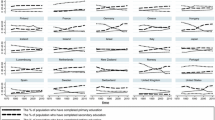Abstract
Human Capital, Trade, and Economic Growth. — Human capital, because of its special role in innovative activity and technological progress, has formed the bedrock of the new theories of endogenous growth. However, it not only serves as an engine of growth but also as a productive input along with labor and physical capital. In this study, the authors find evidence of the importance of both roles of human capital. They also find that the relationship between growth and the external effects of human capital vary according to trade regime. When literacy rates are relatively high, open economies grow about 0.65 to 1.75 percentage points more than closed economies.
Zusammenfassung
Humankapital, Handel und Wirtschaftswachstum. — Wegen seiner besonderen Rolle bei Innovationen und technologischem Fortschritt bildet das Humankapital die Grundlage der neuen Theorien über endogenes Wachstum. Es dient aber nicht nur als Antriebskraft für das Wachstum, sondern ist auch ein produktiver Input wie Arbeit und physisches Kapital. In dieser Untersuchung finden die Autoren Anhaltspunkte für die Bedeutung der beiden Rollen des Humankapitals. Sie stellen außerdem fest, daß die Beziehung zwischen Wachstum und den externen Effekten des Humankapitals mit der Art des Außenhandelsregimes variiert. Bei relativ hohem Alphabetisierungsgrad wachsen offene Volkswirtschaften um 0,65 bis 1,75 Prozentpunkte schneller als geschlossene Volkswirtschaften.
Similar content being viewed by others
References
Barro, R.J. (1991). Economic Growth in a Cross Section of Countries.Quarterly Journal of Economics, Vol. 106, pp. 407–443.
Bhagwati, J. (1978).Anatomy and Consequences of Exchange Control Regimes. Cambridge, Mass.: Ballinger Publishing Co.
— (1984). Development Economics: What Have We Learned?Asian Development Review, Vol. 2, pp. 23–38.
DeLong, J. B., and L. H. Summers (1991). Equipment Investment and Economic Growth.Quarterly Journal of Economics, Vol. 106, pp. 445–502.
Dollar, D. (1992). Outward-Oriented Developing Economies Really Do Grow More Rapidly: Evidence from 95 LDCs, 1976–1985.Economic Development and Cultural Change, Vol. 40, pp. 523–544.
Feenstra, R. (1990). Trade and Uneven Growth. NBER Working Paper No. 3276. Cambridge, Mass.
Grossman, G.M., and E. Helpman (1991).Innovation and Growth in the Global Economy. Cambridge, Mass.: MIT Press.
Heitger, B. (1987). Import Protection and Export Performance — Their Impact on Economic Growth.Weltwirtschaftliches Archiv, Vol. 123, pp. 249–261.
— (1993). Convergence, the ‘Tax-State’ and Economic Dynamics.Weltwirtschaftliches Archiv, Vol. 129, pp. 254–274.
Johnson, H.G. (1960). The Cost of Protection and the Scientific Tariff.Journal of Political Economy, Vol. 68, pp. 327–345.
Kormendi, R., and P. Meguire (1985). Macroeconomic Determinants of Growth: Cross-Country Evidence.Journal of Monetary Economics, Vol. 19, pp. 141–163.
Krueger, A. (1978).Foreign Trade Regimes and Economic Development: Liberalization Attempts and Consequences. Cambridge, Mass.: Ballinger Publishing Co.
Levine, R., and D. Renelt (1992). A Sensitivity Analysis of Cross-Country Growth Regressions.American Economic Review, Vol. 82, pp. 942–963.
Lucas, R.E.Jr., (1988). The Mechanics of Economic Development.Journal of Monetary Economics, Vol. 22, pp. 3–42.
McMahon, W. (1991). Relative Returns to Human and Physical Capital in the U.S. and Efficient Investment Strategies.Economics of Education Review, Vol. 10, pp. 283–296.
Mankiw, N.G., D. Romer, and D.N. Weil (1992). A Contribution to the Empirics of Economic Growth.Quarterly Journal of Economics, Vol. 107, pp. 407–437.
Michaely, M., D. Papageorgiou, and A. Choksi (eds.) (1991).Liberalizing Foreign Trade: Lessons of Experience in the Developing World, Vol. 7. Cambridge, Mass.: Basil Blackwell.
Rebelo, S. (1991). Long-Run Policy Analysis and Long-Run Growth.Journal of Political Economy, Vol. 99, pp. 500–521.
Romer, P.M. (1986). Increasing Returns and Long-Run Growth.Journal of Political Economy, Vol. 94, pp. 1002–1037.
— (1989). What Determines the Rate of Growth and Technical Change? The World Bank Policy, Planning and Research Working Paper No. WPS 279. Washington, DC.
-(1990a). Capital, Labor, and Productivity.Brookings Papers on Economic Activity. Special Issue, pp. 337–367.
— (1990b). Human Capital and Growth: Theory and Evidence.Carnegie Rochester Conference Series on Public Policy, Vol. 32, pp. 251–285.
— (1990c). Endogenous Growth and Technical Change.Journal of Political Economy, Vol. 98, pp. 71–102.
Roubini, N., and X. Sala-i-Martin (1992). Financial Repression and Economic Growth. Journal of Development Economics, Vol. 39, pp. 5–30.
Ruffin, R. (1979). Growth and the Long-Run Theory of International Capital Movements.American Economic Review, Vol. 69, pp. 832–842.
— (1994). Endogenous Growth and International Trade.Review of International Economics, Vol. 2, pp. 27–39.
Schultz, T.W. (1975). The Value of the Ability to Deal with Disequilibria.Journal of Economic Literature, Vol. 13, pp. 827–846.
Solow, R.M. (1956). A Contribution to the Theory of Economic Growth.Quarterly Journal of Economics, Vol. 70, pp. 65–94.
Stokey, N. L. (1991). Human Capital, Product Quality, and Growth.Quarterly Journal of Economics, Vol. 106, pp. 587–616.
Summers, R., and A. Heston (1991). The Penn World Table (Mark 5): An Expanded Set of International Comparisons, 1950–1988.Quarterly Journal of Economics, Vol. 106, pp. 327–368.
United Nations, Department of Economic and Social Affairs (1971).World Economic Survey, 1969–1970. E/4942 ST/ECA/141. New York.
Willis, R.J. (1986). Wage Determinants: A Survey and Reinterpretation of Human Capital Earnings Functions. In O. Ashenfelter and R. Layard (eds.)Handbook of Labor Economics, pp. 525–602. Amsterdam: North-Holland.
World Bank (1987).World Development Report 1987. New York: Oxford University Press.
— (1991).World Development Report 1991. New York: Oxford University Press.
Young, A. (1991). Learning by Doing and the Dynamic Effects of International Trade.Quarterly Journal of Economics, Vol. 106, pp. 369–405.




